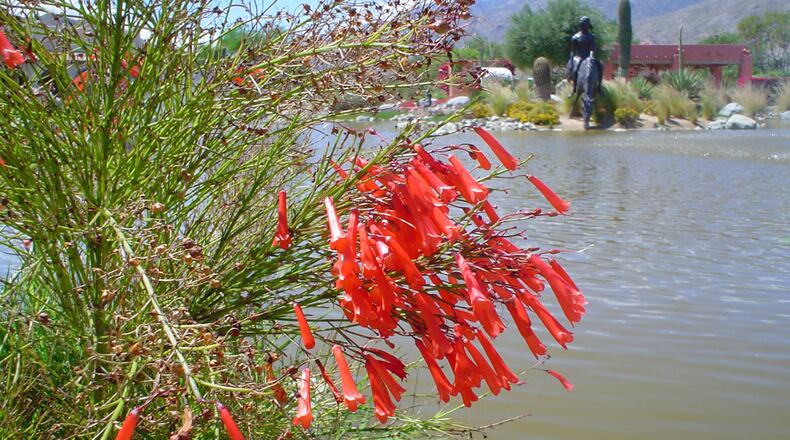The thin foliage is a powerful mechanism against moisture loss, which is why it’s so heat- and drought-resistant. Firecracker is quite capable of growing in the garden too, but note the cascading form often makes a thick skirt of flowers that becomes impenetrable. That results in a wholly different form than in pots. However, when planted with boulders and on slopes, the natural character spills color as it fills in the open spaces.
Long ago the plant took center stage in the warmer lowlands of the Maya. Such cultures recognize the transient nature of the flowers and blood as symbolic of life and death. Naturally the sanguine-colored blooms would be grown around temples and pyramids. Today there is ambiguous nativity within Mexico because amazingly beautiful plants came into widespread cultivation in pre-Columbian times. This would confound modern botanists as to the exact origin of many.
This flower of Mexico does not come up often in books, but growers are busy as demand is high in drought-stricken regions. Now you can buy them in one gallon to very large pot sizes through most garden centers. For quick results in the coming months, match a 5-gallon nursery firecracker with the perfect pot. It should be tall enough to allow dangling without floor sweeping, or add a pedestal for more height. The pot opening should be large enough to drop a 5-gallon nursery pot inside with room to spare. This makes a fine freestanding composition to set your firecracker at the perfect height for an exceptional patio accent until frost.
Coral fountain is another name that describes its very unique and graceful habit. Young plants are spindly like Sprenger asparagus house plants. Early on, thin dark stems rise from the center upward to arch only after enough foliage or a good crop of flowers weighs it down.
What we do know about the plant is it prefers more ordinary well-drained potting soil. It’s a very drought-resistant species that looks differently depending on where it is and how you care for it. A sparse wispy look is more transparent, which occurs with infrequent watering and minimal feeding. For really lush specimens, maintain moderate fertility with regular feedings to stimulate more stem growth that results in a larger plant.
Frost is the Achilles heel of where firecrackers grow over time. They are supposedly hardy to 24 degrees Fahrenheit, but that likely kills back much of the tender growth. Growing in pots allows you to move them to shelter or indoors for winter.
Firecrackers should be our plant of the year during ongoing drought. They are chameleons that raise succulent gardens to a whole new level. They are essentials of Spanish style architecture, modernists love their pop and textures, and they fit in with tropical landscaping suffering for moisture. Why not take a chance on some fireworks this summer to transform dry garden doldrums with red hot color, hummingbird parties and an entirely new fine-textured plant to play with?
———
Maureen Gilmer is an author, horticulturist and landscape designer. Learn more at www.MoPlants.com
About the Author
